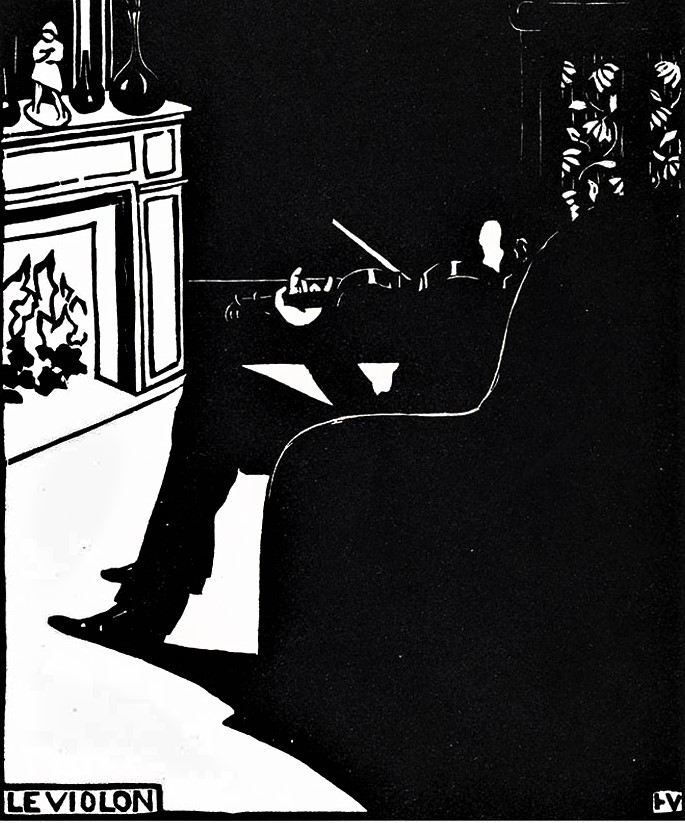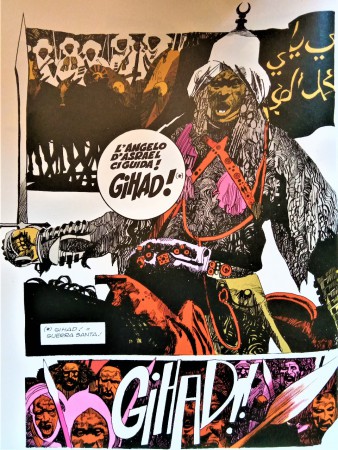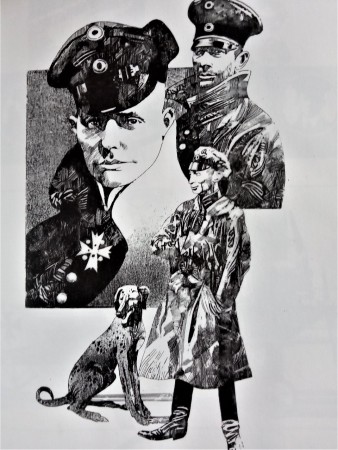PICTURE ENJOYMENT: VALLOTTON AND TOPPI
Tags:
T.ex.: semester | bil | arbete Some genres have almost exclusively been judged within a framework limited by preconceived notions. Science fiction was obviously such a world for a long time | and it is probably still the case that a thought-provoking author
Today, as so often before, I bought two magazines in the newsstand around the corner – Art e dossier and I grande maestri. Arte e dossier is a lavishly illustrated art journal, issued monthly. It contains the latest news from the art world, descriptions of exhibitions all around the world, and interesting articles. It comes with a supplement describing the life and works or an artist, art from a particular time and area, or an art movement, or trend.
.jpg)
I grande maestri is a suite of comic books that each month presents stories from famous, mainly Italian and French, cartoonists. In both France and Italy, there is a great interest in sophisticated, skillfully made and told comics, a wide range of such publications are published every month, both in the form of books and magazines.
.jpg)
Comic strips, in Italian called fumetti, from the balloons containing words uttered by cartoon characters, are often called la nona arte, the nineth art. I assume the other eight must be music, painting, sculpture, poetry, dance, architecture, film, and television. Although it makes me wonder about the status of fashion and craftsmanship. The special copy of I grande maestri I try to purchase each month contains comic strips drawn and often written by Sergio Toppi (1932 – 2012).
This month´s Art e dossier supplement was about Félix Vallotton (1865 - 1925), who was born in Lausanne but spent his life in France.

The I grande maestri with Toppi stories was called Trame, which may be translated as plots/territories, and included five stories around the New Testament, a medieval legend and a historical depiction of the Dutch colonization of Indonesia in the late 16th century.

Even if the two magazines obviously had nothing in common they made me remember last summer when I and my wife spent some time in Honfleur on the Normandy coast. We had ended up in a very special gîte de passant, bed & breakfast – a nineteenth-century villa looking as if it could have the setting for some history by Flaubert or Maupassant.
.jpg)
Our room could also have been taken out of some French nineteenth-century novel. Such an impression was underlined by our host's well-stocked library of French classics and his enjoyable piano playing – Bach suites and Schubert sonatas. He was a very friendly and forthcoming man, but between us we called him Norman, after Norman Bates of the horror motel in Hitchcock´s Psycho, this was because he was a bachelor, looked like Anthony Perkins and had his house filled with stuffed animals. However, the villa was far from being a place of horror – clean, bright and tidy.
.jpg)
Every morning we were served a plentiful and delicious breakfast, laid out solely for us in an eye-catching and evocative salon with African masks, Japanese lacquer screens. eighteenth-century portraits, stuffed paradise birds and all kinds of other strange things.
.jpg)
Next to the salon was a boudoir with vermilion tapestry, bedspreads, hangings, and curtains.
.jpg)
Right next to the bed was a large, somewhat clumsily stuffed penguin.
.jpg)
By the fireplace was a swordfish head.
.jpg)
All those strange and exotic artifacts made me think of Toppi's comics. They often deal with eccentric, old antiquarians who often serve as narrators in his stories.

Ancient geezers surrounded by books and antiquities, perhaps inspired by Oesterheld's and Breccia's Argentine comic book series Mort Cinder, which among connoisseurs is considered to be a classic masterpiece. They tell about an old antiquarian, Ezra Winston, who owns a curiosity shop in London and in company with the immortal Mort Cinder from time period to time period. They are pursued by a group of appalling “lead-eyed” characters who plan to use Mort Cinder's brain for gruesome experiments.

.jpg)
The reason I came to associate Vallotton with Honfleur was that he often stayed in this charming coastal town, which also attracted several other significant artists and still is filled with art galleries. One of the nineteenth century's important inspirers for other artists, Eugène Boudin, was born in Honfleur. His great importance is based on his fame of being a forerunner to the Impressionists' s and a source of inspiration for many of them. The city's museum is named after him.

Another museum housed in the city is Erik Satie's childhood home, another of Honfleur's great sons, who seems to be increasingly appreciated as one of the great geniuses of the last century, not only in the field of music but also as an inspirer for several branches of modern art, especially in their playful and absurd aspects. When Satie was four years old, the family moved to Paris, but when his mother died two years later, he returned to Honfleur where he lived with his grandparents until he as a teenager was reunited with his father in Paris.

While browsing the magazine with reproductions of Vallotton's paintings, I recognized a view of Honfleur, which corresponded with the one we had from a meadow just below the house we lived in. In Vallotton's painting, the small town is covered by mist, though the sun shone every day we stayed there.
.jpg)
Otherwise, Valllotton's landscapes are generally bright and sunny, especially those he painted in Honfleur and Normandy.
.jpg)
However, his unique graphics are generally dark and use sharp contrasts between white and black.
.jpg)
From time to time they are almost completely black.
.jpg)
Many of his woodcuts radiate melancholy and loneliness. Even when they depict couples, something they often do, the two actors involved seem to be contained within themselves.

His visual language is extremely simplified. He expressed himself by minimal means, but that did not prevent him from imparting his artwork with intense emotions. Like this presentation of a piano recital where the pianist is made from a few lines. She is wearing a bright dress and placed against a white background, while the intensively listening gentlemen are placed in the dark, each in a pose separated from those of the others, but nevertheless attesting to an intensive experience. All five men seem to be enthralled by the music, though each of them in his own way.

In a similar manner, Vallotton succeeds in a woodcut he calls ”patriotic couplet” – each of his graphic sheets is like those of Goya endowed with a title – with the same modest, subtle means in reproducing a variety of emotions of an engaged audience.

Vallotton was a radical man who worked for Le Cri de Paris, the city's leading leftist publication and La Revue Blanche, radical as well, though with a more artistic approach. Vallotton's radicalism may be regarded as anarchic and occasionally manifested itself through his dynamic depictions of riots and demonstrations, as always using empty and filled surfaces.
.jpg)
Vallotton did not hesitate to condemn violence, especially the brutality of authorities.

Even more, however, he portrays marital intimacy, the tension between man and woman. In a picture, he depicts how a man sits in the dark waiting for a woman to finish her evening preparations.

As so often in his other woodcuts, the woman stands in the light. The picture makes me think of a song by Charles Aznavour, Happy Anniversary:
I've been ready for hours and I'm wearing my best,
ordered champagne and flowers and you're not even dressed
It is all too absurd, you're so cross and abrupt,
but I don't say a word or you're bound to erupt.
Your peculiar moods I've experienced before
so I'll pour another drink and quietly pace the floor.
.jpg)
Music, loneliness, darkness, and light are often present by Vallotton.

Dynamic shapes, white and black, empty surfaces interact with completely blackened areas.

After looking at Vallotton's woodcuts and then studying Toppi's comic strips, I found that he often works in a similar manner. Like here, where Emiliano Zapata's mighty sombrero consists solely of a white field.

A naked woman's shapes appear against a black surface.

The body of a World War I soldier stands out as a white, empty surface against a black background.
.jpg)
As with Vallotton, we find a lone figure standing isolated from groups, in this case, an African cow separated from her flock by white, empty space.

The black shadow on the neck of a terrified German soldier becomes the scene of a nightly assault where the attackers are portrayed as white silhouettes.
.jpeg)
Like by Vallotton there is a lot of music present in Sergio Toppi´s comics. It can be a violinist performing in an eighteen-century castle,

or a saxophonist playing in a junkyard somewhere in the southern states of the United States.

An impoverished blues guitarist becomes the representative of the oppressed people Toppi often portrays and from whose perspective he tells his stories.

He does, for example depict aboriginals´ conflicts with bandits within Australia's wastelands.
.jpg)

Toppi often finds unexplored and lesser-known areas to depict such conflicts. For example, encounters and battles between Inuit and Vikings in medieval Greenland.

Or the Florida Seminoles' desperate fight against the United States Army between 1818 and 1858.

Toppi moves freely across ages. He follows mammoth hunters during the Stone Age.

South Tyrolean bandits during the sixteenth century.

German soldiers during the Seven Years War, in scenes that make me think of Stanley Kubrick's Barry Lyndon.

Japanese samurai.

Englishmen fighting The Mahdi's religiously inspired army in Sudan.

Forgotten gods, ancient riuals and bodhisattvas.
.jpg)
.jpg)
.jpg)
American gangsters and corrupt cops.

He brings us straight into the Vietnam War,

as well as into an unknown future.

Like by Vallotton, violence can suddenly explode within Toppi´s comic strips.
.jpg)
It often occurs during encounters between widely different cultures, like when he tells the story about an ingenious Scotsman ending up in a Canadian conflict during the eighteenth-century wars between French, English, and Mohicans.

The pages of Toppi's comic books are often composed in a cinematically dynamic manner as if inspired by scenes from a western film by Sergio Leoni. It may like here be a hunter aiming at an attacking rhino,

or a Russian cavalryman shot down by an English adventurer.

Occasionally Toppi contrasts overloaded drama with calm, almost empty surfaces, as here where the demon Iblis suddenly reveals himself to a lonely desert wanderer.

Like so many other creators of comics, Serio Toppi does not shun horror and mystery, often transforming characters known from history into frightening figures. As with a Polish rider from Sobieski's fight against the Turks during the Battle of Vienna in 1683,

or when he demonizes an Ethiopian priest during his meeting with a cynical adventurer.

Beautiful women often occur in Toppi's comic strips, they might be portrayed from a slightly ironic angle, like this desirable woman who exposes herself in one of the Titanic´´s cabins while Toppi´s frequent inspirer, Gustave Klimt, may be discerned in the background.

Toppi´s concept of beauty tends to have a tinge of exoticism,

and he often reveals a capacity to capture the beauty of older women.

In particular, he excels in depicting the mysterious allure of oriental beauties like those found in tales from The Arabian Nights. He often depicts them in colour, in a dark gleaming manner.


Although Sergio Topp seems to have a fondness for dynamically designed, almost chaotic and overloaded imagery, he may also produce more quiet imagery, especially in the many comic strips he has done based on biblical motifs, where he also uses more colour than he usually does, though in a more subdued manner.

Nature is often present in Toppi's compositions.


His depictions of nature are generally dynamic, varied and detailed. As usual, he tends to create dense panoramic patterns in which he likes to integrate different species of strange animals.

He often lets the animals speak and even direct the course of events.

They may be victims, like the slaughtered seals in a series about Norwegian hunters in the Arctic by the beginning of the last century,

or moose being shot by Russian hunters during the nineteenth century.
.jpg)
However, animals may also tell stories, Toppi then moves the perspective down to their level. Like the one of a Komodo Dragon,

or a gazelle in Arabia.

An armadillo getting lost in a fairy tale world.

Toppi also portrays known celebrities, paying attention to leaders from all over the world, and within different eras. It may be Shaka Zulu in southern Africa,

Taras Bulba in Ukraine,

Genghis Khan,
.jpg)
Federico II of Svevia,
.jpg)
Custer and Sitting Bull,
.jpg)
.jpg)
Baron von Richthofen.

He mixes time epochs and locations. He may, for example, let an evil gnome cause German arrogance.

An English adventurer from the nineteenth century gets involved with the fighting between Vikings.

Toppi might also pay homage to other masters, more famous than him. Like Hugo Pratt and his legendary adventurer Corto Maltese,

or Tiziano Sclavi's ”Nightmare Detective” Dylan Dog.

Toppi´s strength is his ability to depict a story in an often unexpected, but nevertheless easily detected personal manner, which also is anthropologically/historically correct and attentive to small, significant details. The stories he tells are generally not as memorable, surprising and effective as, for example, those of Hugo Pratt. However, like Hugo Pratt's hero Corto Maltese, Toppi's characters, if they are not outright evil, tend to have an impressive bearing and radiate stoic loneliness, paired with a certain cynicism, regardless from whatever culture they originate.
.jpg)
.jpg)
And then there are the old men surrounded by old papers and gadgets,

who, in an age of increasingly technical perfection, insist on toiling with paper and pencil.

Or who sit lost in reveriee or dreams about adventure.

For once, I have put together a blog with more pictures than text. Maybe my fascination with Sergio Toppi's visual world has thrown me off track and I have possibly given him more appreciation than what others assume he is worthy of. What do I know? Toppi´s
unique depictions of adventures within a world without borders involve all kind of people, as well as animals and span thousands of years. Such stories and imagery still speaks to the eager and adventurous child that has remained inside me.
Comic books have only recently received some of the attention I assume they deserve. Sergio Toppi, whose magazines, books and comic strips now have been translated into several languages worked throughout his life as a cartoonist in various children's and youth magazines and did not receive much appreciation among art connoisseurs. He was appreciated and judged within the specific crowd that moved within the world of comics, outside such groups Toppi was virtually unknown.
We have a tendency to judge works within the framwork of their assigned genre and many of us may thus miss the stimulating acquaintances with worlds beyond what we perceive as our special interest area. I know women who only read what they call "women's literature". Others I know only read thrillers and murder mysteries.
.jpg)
Some genres have almost exclusively been judged within a framework limited by preconceived notions. Science fiction was for along time obviously suffering from such limitations, and that might still be the case. A thought-provoking author like Liu Cixin, who recently took hold of me through his visions of Chinese politics and parallel worlds, is probably mostly read and commented on by science-fiction fans. One of them is apparently former US president Barack Obama, who in a New York Times interview stated:
Sometimes you read fiction just because you want to be someplace else. […] the stuff I read just to escape ends up being a mix of things – some science fiction. For a while, there was a three-volume science-fiction novel, the “Three-Body Problem” series, which was just wildly imaginative, really interesting. It wasn´t so much sort of character studies as it was just this sweeping … The scope was immense. So that was fun to read, partly because my day-to-day problems with Congress seems fairly petty – not something to worry about. Aliens are about to invade. [Obama laughs].
Another genre suffering from a similar closeting is in all likelihood horror fiction. It took a long time for a master like Stephen King to be judged outside the limits of that particular genre frames and to be recognized as the skillful writer he actually is (usually – he has written quite a few flops as well).
.jpg)
So let us like Sergio Toppi pay homage to diversity and enjoy the pleasures it may offer. My fascination with Sergio Toppi´s art supports my faith that make-believe does exist and is a force to reckon with. So is music, painting, sculpture, poetry, dance, architecture, film, and television, as well as theatre, religion, fashion and craftsmanship. However, like everything that is beautiful, desirable and thought-provoking the arts have to be savoured with care and moderation, something that in my opinion are essential conditions for true aesthetics.

It’s interesting, the stuff I read just to escape ends up being a mix of things — some science fiction. For a while, there was a three-volume science-fiction novel, the “Three-Body Problem” series, which was just wildly imaginative, really interesting. It wasn’t so much sort of character studies as it was just this sweeping … The scope of it was immense. So that was fun to read , partly because my day-to-day problems with Congress seem fairly petty — not something to worry about. Aliens are about to invade.





